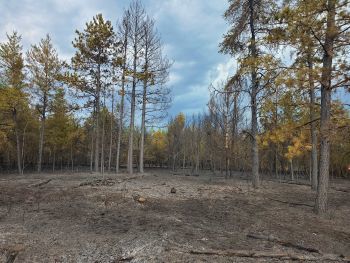|
May 18, 2022
Contact: Kerry Heckman, 517-643-1256
Blue Lakes Fire response in final stages; DNR thankful for help

As DNR fire crews continue to identify and mop up hot spots within the 2,516-acre Blue Lakes Fire, all roads and the Black River have reopened.
The Michigan Department of Natural Resources got a lot of help in fighting the fire, located northwest of Atlanta in Montmorency and Cheboygan counties, since it was reported around 12:40 p.m. Friday.
“We’d like to express appreciation for the assistance and support of all the partners and cooperators involved,” said Kerry Heckman, public information officer for the DNR’s Incident Management Team.
Among those assisting were DNR Law Enforcement; USDA Forest Service; Montmorency County Sheriff’s Department and Emergency Management; the Tri-Township, Hillman Area, Lewiston, Vienna, Albert Township, Charlton Township and Onaway fire departments; the Canada Creek Ranch Fire Brigade; Onaway, Hillman Area, Tri-Township and Cheboygan EMS and the Michigan State Police.
The DNR also thanks the local community for its support, including numerous donations of food and water throughout the past several days and their willingness to respect the road closures, put safety first, and give crews the space they need to safely and effectively contain the fire.
|

Wildlife spotted returning to fire area
Although the fire is mostly contained and the area has opened back up, people still need to be careful in the fire area. Be aware of snags – burned trees that can fall without warning – especially when it’s windy. It’s normal to see some smoke in the blackened area and it isn’t a cause for alarm. Both people and pets should avoid walking in blackened areas, as there may still be hot spots. Stay on the roads and keep pets on leashes.
If you’re driving through the area, reduce your speed and watch for increased movement of wildlife. It’s common for wildlife to move from their home areas to avoid flames and seek new habitat. A variety of wildlife has been spotted returning in the burned-over area, including elk, deer, porcupines, turkeys and a scarlet tanager.
The fire started with a lightning strike on May 11 which smoldered for a couple of days until nearby brush, leaves and other fuels dried out enough to catch fire and spread the blaze.
To help prevent future fires, always remember to check Michigan.gov/BurnPermit regarding burn permits in your area, and follow safety suggestions on Michigan.gov/PreventWildfires.
|
Note to editors: Accompanying photos are available below for download. Caption information follows.
-
Post-fire forest: Following the Blue Lakes Fire, forest visitors may see areas with burned undergrowth and scorched, live conifer trees.
-
Porcupine: A porcupine, seen climbing on a pine branch, returns to the fire area.
See all photos, videos and maps from the Blue Lakes Fire in this online gallery.
|